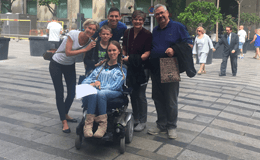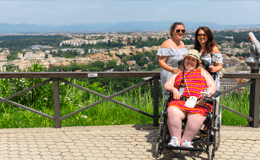Highlights of this tour
- Deák square
- Váci street
- Ruins of Castle Contra Aquincum
- Duna Corso
- Vörösmarty square
- Széchenyi square
- Saint Stephen Basilica
- Liberty square
- Houses of Parliament
The start of this wheelchair accessible walking tour of Budapest depends on the location of your accommodation. Your English-speaking guide meets you in the lobby of your hotel. From there, you walk through the city or take accessible city transport together. The first stop on your tour is the Deák Square. The last stop of the trip is the Houses of Parliament. Discover the beautiful city of Budapest during this wheelchair accessible walking tour.
Deák Square is located in the heart of Budapest, and with that, it is one of the busiest squares of the city. Underneath the square, three metro lines meet. Therefore, it is the metro hub of Budapest. Besides that, you find trams, buses, and the famous hop-on, hop-off busses above ground. A tourist attraction for many.
The pedestrian street Váci is very trendy among tourists. The southern part of the road is a series of souvenir shops and restaurants, where especially the national Hungarian cuisine is frequently served. The beautiful thing about the street is that you do not see large shops of well-known international brands. You mainly find local entrepreneurs who try to sell their goods. Váci Street is the place to buy authentic souvenirs such as Hungarian crystal, folkloric clothing, and local wines.
In Roman times Budapest was divided into Buda and Pest and separated by the river Danube. During these days, Pest was called by its Roman name Contra-Aquincum, and they called Buda, Buda Aquincum. Nowadays, together they form the Hungarian capital Budapest. Emperor Diocletian founded Contra-Aquincum in 294 as a part of fortification works. Every border was strengthened during this time with various strongholds. Contra-Aquincum was located where you find the bridgehead of the Erzsébet Bridge now. Today, only a ruin of the Roman fortress is left to visit. At this stop, you discover the roman heritage of Hungary.
The Duna Corso is the Danube Promenade. While strolling along here, you see the Vigadó. The Pesti Vigadó is a cultural center that opened in 1865, centrally located in Budapest on the east bank of the Danube. Since March 14, 2014, it has reopened after a renovation and is partly open to the public. A second building called Vigadó is located in Buda: the Budai Vigadó. The visit to the Vigadó is from the outside, but if wished, an inside visit can be arranged.
Vörösmarty Square is located in the center of Pest. The square is one of the most atmospheric squares in the city of Budapest. In the summer, they organize events like open-air performances here. While in the winter months, Vörösmarty Square is the setting of the Christmas market. Around the square, you find several terraces, bars, various kinds of shops, and restaurants. Here, you also see the famous coffee house Gerbeaud, where the Swiss coffee master with the same name started to serve his guests delicious coffee in the mid-nineteenth century. You also find a giant statue of the Hungarian poet Mihály Vörösmarty on the square. He is the writer of the Hungarian anthem, and the Hungarians named the square after him.
Széchenyi Square used to be named Roosevelt Square. In 2011, its name changed. Now, it is a tribute to Count István Széchenyi. From this Square on the Danube in Pest, you have a beautiful view of the famous Chain Bridge and the Castle District. The Chain Bridge is the oldest in the city. Besides that, you also find a statue of Széchenyi and the building of the Academy of Sciences he founded.
The 96-meter-high dome of St. Stephen’s Basilica dominates the Pest district. It is Budapest’s largest church that can hold up to 8,000 devotees. The construction of this church came with a few problems. The architect that started construction in 1851 died before he completed the project. His successor discovered large cracks in the walls and some other issues. Less than a week later, the dome collapsed.
Architect Miklos Ybl then rebuilt the church in a neo-Renaissance style. The opening of the church took place in 1906. The interior is richly decorated with frescoes and engravings and holds more than 50 different types of marble. The church was named after the country’s first Christian monarch, King Stephan. He died in 1035. The king’s mummified right hand is kept in a separate chapel and is carried in a procession on August 20 each year.
When you go up to the tower, you are treated to a beautiful view of Budapest.
The spacious Liberty Square was built at the end of the nineteenth century. The square is bordered by monumental buildings that symbolize the growing wealth of the city at the time. These buildings are the stock exchange building, the Hungarian National Bank, the American Embassy, the Soviet monument, and various other monuments. The square is a mix of business and residential life.
The Hungarian Parliament Building is one of the most impressive buildings in the city of Budapest. It is located on the Danube, in the Pest district. The neo-Gothic building was designed in 1885 and was not completed until 1902. The most beautiful place to admire the architecture is across the Danube in Buda. Do you want to know more about this building, read everything you need to know in this blog post.
This wheelchair accessible tour does not include an inside visit to the Parliament Building. If you would like to add this visit, let us know beforehand so we can arrange your accessible tour of Budapest completely to your wishes.

“Mirjam helped us put together a trip of a lifetime in Europe. I appreciated her patience with my many…” Read more

“…Would definitely recommend Disabled Accessible Travel.” Read more

“I just wanted to let you know how much I enjoyed…” Read more

“I just had the most INCREDIBLE trip to Spain, Barcelona specifically, all because of Mirjam …” Read more